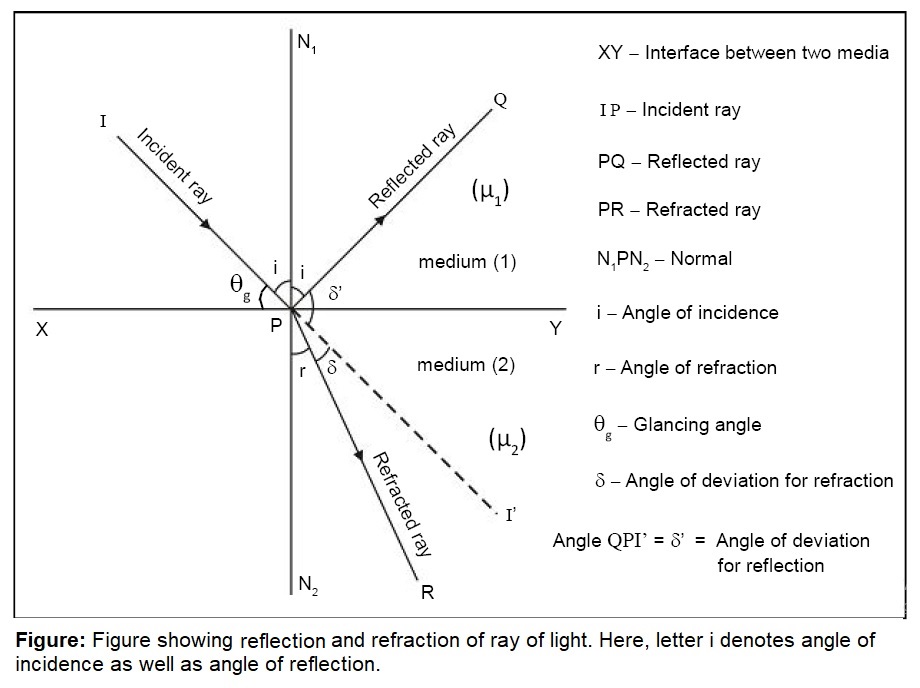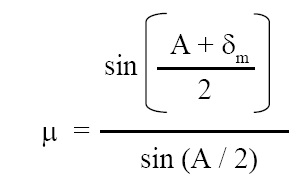Physics - Grade XI or Standard XI
Chapter 8: Refraction of Light
Monochromatic light:
A wave of light of single frequency (or wavelength) is called monochro- matic light. Mono means one and chrome means color. Literally monochromatic light means light that consists of only one color.
Partial reflection of light:
When a ray of monochromatic light is incident is incident obliquely on the interface of two media, part of the light is reflected back into the same medium. This phenomenon is called partial reflection of light.
Angle of incidence:
The angle between incident ray and normal is called angle of incidence.
Angle of refraction:
The angle between refracted ray and normal is called angle of refraction.
Glancing angle:
The angle made by incident ray with the reflecting surface or interface is called glancing angle.
Angle of deviation for refraction:
The angle between the incident ray (i.e., original path) and refracted ray is called angle of deviation for refraction.
Angle of deviation for reflection:
The angle between the incident ray (i.e., original path) and reflected ray is called angle of deviation for reflection.
Click Here to Go To Top of The Page
Snell’s law of refraction:
Snell’s law of refraction is given by following expression :
1μ2 = (sin i) / (sin r) = constant
where i = angle of incidence in medium 1, r = angle of refraction in medium 2, 1μ2 = refractive index of medium 2 with respect to medium 1 = constant.
Relative refractive index (1μ2):
Refractive index of medium 2 with respect to medium 1 which is denoted by symbol 1μ2 is called relative refractive index. It is also given by the expression given below:
1μ2 = v1 / v2 = μ2 / μ1
where v1 = velocity of light in medium 1, v2 = velocity of light in medium, μ2 = absolute refractive index of medium 2, μ1 = absolute refractive index of medium 1.
Click Here to Go To Top of The Page

Click Here to Go To Top of The Page
Absolute refractive index (μ):
In case of relative refractive index 1μ2, if medium 1 is vacuum then the resultant refractive index is called absolute refractive index of medium 2. It is given by the following expression:
μ = c / v
where μ = absolute refractive index of medium 2, c = velocity of light in vacuum, v = velocity of light in medium 2.
Bending of refracted ray:
When a ray of light travels from optically denser medium to optically rarer medium it bends away from the normal and when a ray of light travels from optically rarer medium to optically denser medium it bends towards the normal.
Principle of reversibility of light:
If, after undergoing number of reflections and refractions, the direction of a ray of light is reversed, the ray traces its original path in the reverse direction. This principle is called principle of reversibility of light.
Critical angle:
Critical angle for the given pair of media is nothing but that value of angle of incidence for which angle of refraction is 90o and ray of light is travelling through denser medium and is incident on the surface of rarer medium.
Total internal reflection:
When a ray of light passing through a denser medium is incident on the surface of a rarer medium at an angle greater than the critical angle, the ray is totally reflected in a denser medium. This phenomenon is called total internal reflection.
Click Here to Go To Top of The Page
Applications of total internal reflection:
(a) in making of reflecting prisms,
(b) in making of periscopes (periscopes are used in submarines),
(c) in making of prismatic binoculars,
(d) in cutting the diamonds,
(e) in making optical fibre cabel,
(f) in explaining mirage.
Optical fibre cable:
It is a cable through which light is transmitted over long distances without any loss in transmission. It is based on the principle of total internal reflection.
Core:
The central part of optical fibre is called core. Its R.I. (Refractive Index) is typically 1.7.
Cladding:
The optical fibre is coated with a thin layer of a material called cladding. Its R.I. is typically 1.5. Thus core of optical fibre is optically denser than outer layer so that light passing through optical fibre should suffer total internal reflections.
Click Here to Go To Top of The Page
Applications of optical fibre cable:
(a) in making endoscopes (endoscopes are used for medical examination of inner parts of the body of a patient),
(b) for transmission of telephone signals over long distances,
(c) for transmission of sound and picture signals over long distances using light pulses.
Dispersion of light:
The separation of white light into its constituent colors after passing through a prism is called dispersion of light.
Spectrum:
When a white light is allowed to incident on prism then colored band of light emerges from prism due to dispersion. This colored band of light is called spectrum.
Prism:
Prism is a part of transparent medium bounded on two sides by plane surfaces inclined to each other. The inclined plane surfaces are also called as refracting surfaces.
Refracting angle of prism:
The angle between the two inclined plane surfaces is called refracting angle of prism.
Refracting edge of prism:
The line along which the refracting surfaces meet each other is called refracting edge of prism.
Base of prism:
A face opposite to refracting edge is called base of prism.
Click Here to Go To Top of The Page
Principal section of prism:
A section of prism which is perpendicular to its refracting edge is called principal section of prism.
Angle of minimum deviation of prism (δm):
As the angle of incidence i increases, angle of deviation δ initially decreases, reaches a minimum value (δm) and then it goes on incresing. The minimum value of δ is called as angle of minimum deviation δm.
Prism formula:
Prism formula is nothing but an expression for refractive index of material of prism (μ) and it is given below:

where μ = R.I of material of prism, A = refracting angle of prism, δm = angle of minimum deviation.
Thin prism:
A prism having very small refracting angle is called a thin prism.
Click Here to Go To Top of The Page
Prism formula for thin prism:
For thin prism, the prism formula is given by the following expression:
δm = A (μ – 1)
where δm = angle of minimum deviation, A = refracting angle, μ = R.I. of material of prism.
Refractivity:
The quantity (μ – 1) is called refractivity of the material of prism.
Angular dispersion:
The angular separation between two extreme colors in the dispersed beam of light is called angular dispersion. For white light, red and violet are the extreme colors, therefore:
Angular dispersion = δviloet – δred
where δviloet = angle of deviation for violet color and δred = angle of deviation for red color.
Dispersive power (ω):
The ratio of the angular dispersion between the extreme colors to the deviation of mean color is called the dispersive power (ω) of the material of prism. The dispersive power of a prism measures its ability to disperse the beam of light into its constituent colors.
Click Here to Go To Top of The Page
Achromatic combination of prisms:
A combination of prisms (typically flint and crown prisms) in which a ray of light suffers deviation without dispersion is called an achromatic combination of prisms.
Rainbow:
Rainbow is the spectrum of sunlight formed in the sky due to reflection, refraction, and dispersion of sun rays by water droplets suspended in the air. It is in the form of bright, concentric arcs of different colors, namely, VIBGYOR (violet, indigo, blue, green, yellow, orange, red).
Primary rainbow:
A rainbow in which the VIBGYOR sequence of colors with red above and violet below is called as primary rainbow.
Secondary rainbow:
A rainbow in which the VIBGYOR sequence of colors with violet above and red below (oppposite to that of primary rainbow) is called as secondary rainbow.
Axis of rainbow:
The straight line joining the Sun and the observer along which centre of both the primary and secondary rainbow lies is called as axis of rainbow.
Scattering of light:
When a ray of light is incident on extremely small object (particle), that object deflects the light in different directions. This phenomenon is called scattering of light. Also, when a beam of light is incident on non-shining and rough object that object disperses the light in all possible directions. This phenomenon is also called scattering of light.
Click Here to Go To Top of The Page
Rayleigh’s law of scattering:
Rayleigh propsed this law for scattering of sunlight by atmosphere. Rayleigh’s law of scattering states that the intensity (I) of scattered light is inversely proportional to fourth power of the wavelength (λ) of light.
Application’s of Rayleigh’s law of scattering:
(a) This law explains why color of sky is blue. As wavelength of violet, indigo, and blue is least compared to other colors, these colors are scattered in more quantity (as scattering is inversely proportional to fourth power of the wavelength) in the atmosphere. Consequently sky appears blue (mixture of viloet, indigo, and blue),
(b) This law explains why color of Sun at sunrise and sunset is red. During sunset and sunrise, sunrays travel more distance through atmosphere before reaching the observer. As wavelength of red color is maximum, it is scattered in least quantity in the atmosphere. Consequently, red color is absorbed in least quantity in the atmosphere and reaches the observer in maximum quantity, and to observer, Sun appears red.
Click Here to Go To Top of The Page